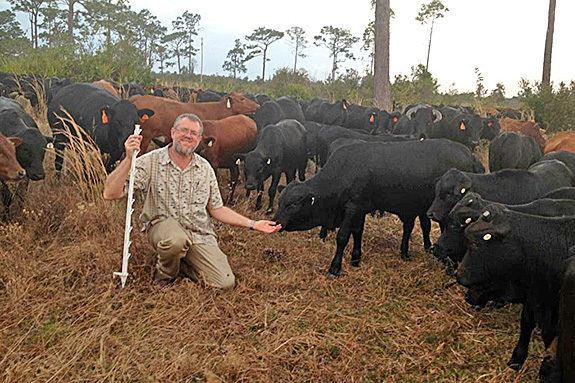Elizondo’s journey with grazing began in his early days spending time with his father and grandfather in Mexico who ranched in the tropical regions near the Gulf.
Here the grasses were tropical, warm-season and what he describes as “low-octane,” meaning they were low in protein.
Today, Elizondo manages a ranch in north-central Florida where he runs Mashona cattle, an African breed.
He rotationally grazes the herd during the growing season and during the winter dormant season utilizes ultra high-density grazing to maximize efficiency of forage harvest on stockpiled warm-season grasses.
Forages present include bahiagrass, bermudagrass, torpedograss and a variety of native and introduced legumes.
Ultra high-density grazing (UHDG) is a form of rotational grazing where livestock are grazed in very high stocking density on a management unit for very short periods of time.
Through mentors like Mark Bader, famous for developing the free-choice mineral supplementation system for cattle, and Johann Zietsman of Zimbabwe, Elizondo has learned how to improve the quality of his grasses through proper mineral supplementation and implement UHDG successfully to maximize his ranch’s profit.
“I use this type of management because it is the most reasonable and logical way of improving the land through the mouths and hooves of our adapted cattle,” he says. “There is no other way that gives such a big sustainable return on investment, both biological and monetary.”

Using a combination of mineral supplementation, UHDG, and winter stockpiling has allowed Elizondo to improve the profitability and sustainability of his ranch.
“Calculated savings go from $100 to $200 per cow per year compared to normal practice in the area,” he says. “Plus, we carry double the normal stocking rate while improving the soil and respecting wildlife.”
For others interested in giving winter stockpiling a try in tropical, warm-season grass regions, Elizondo suggests starting stockpiling during the growing season. Depending on the environment, a grazier should set apart from one-third to one-half of the ranch for stockpile.
Elizondo also suggests checking cattle’s urine pH as a way to judge if cattle need extra protein. A normal pH is around 7. You can talk to your veterinarian to find out how to do this.
Other important factors to consider to guarantee cattle are utilizing forage effectively are manure for digestion of fiber, fill of the cow, body condition changes, cattle behavior from a distance and general appearance.
He says, “Be certain your mineral program is working, as I have seen wrecks where the mineral program was not good.”
Lastly, he adds, “Any grass can be utilized (for stockpiling), all you need to do is balance the ration with whatever is needed.”
Elizondo’s goal has always been world-class in whatever he does. With grazing he has certainly done just that.
He has sought out the best in the world to learn from and continually uses this knowledge to increase what he calls sustainable profits in ranching.
You can learn more about Elizondo’s unique grazing management practices on his website, Regengraze. FG
Jesse Bussard is a freelancer writer based in Montana.
PHOTOS
TOP: Florida rancher Jim Elizondo uses ultra-high stocking densities for short periods of time to rejuvenate pastures and maximize yield.
BOTTOM: Mashona cattle graze in ultra-high stocking densities on warm season grasses and native legumes. Photos by Jesse Bussard.











